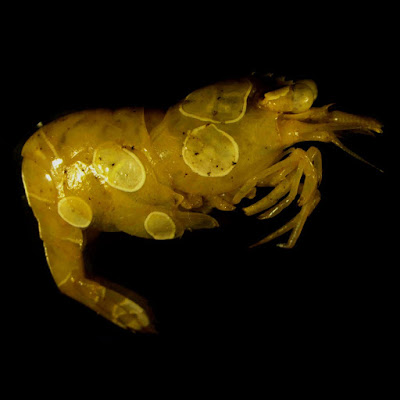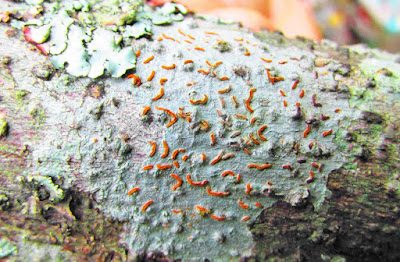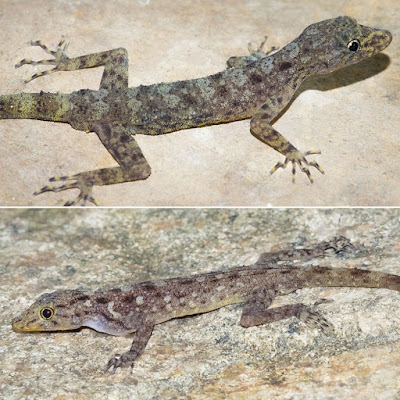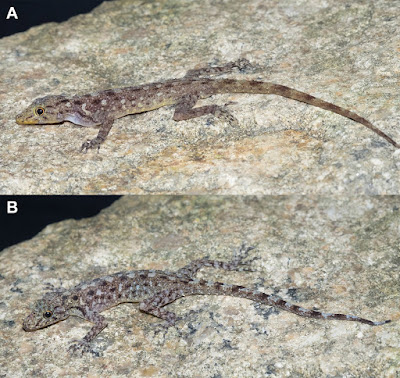[Most Recent Entries] [Calendar View]
Monday, July 1st, 2019
| Time | Event | ||||||
| 2:37a | [Crustacea • 2019] New Record of Thor hainanensis and Taxonomical Remarks on Lysmata ternatensis (Decapoda: Thoridae & Lysmatidae) from the Lakshadweep Islands, India
Abstract The present study reports the new record of Thor hainanensis Xu & Li, 2014, on the basis of material from Agatti Islands in the Lakshadweep, India. This species was recently described from Hainan Island, China. Relationship of this species to two closely related species (T. paschalis and T. amboinensis) is discussed in this manuscript. Similarly, the present study also reports the rediscovery of other species, Lysmata ternatensis De Man, 1902 from the Lakshadweep waters with detailed taxonomic description. The present specimens were found to occur in the intertidal region in small crevices and rocks at a depth of 0.5-2.0 m. Genetic analysis using the mitochondrial COI sequences for both the species reveals close agreement for the morphological identification and showed the significant variation from the closely related species. Keywords: Crustacea, Agatti Islands, cytochrome oxidase subunit I, taxonomy, Lysmata, Thor Manu Madhavan, P. Purushothaman, S. Akash, S. Bharathi, Sheena Jose, A. Dhinakaran, Charan Ravi, T.T. Ajith Kumar and K. K. Lal. 2019. New Record of Thor hainanensis Xu & Li, 2014 and Taxonomical Remarks on Lysmata ternatensis de Man, 1902 (Decapoda: Thoridae & Lysmatidae) from the Lakshadweep Islands, India. Zootaxa. 4624(3); 351–364. DOI: 10.11646/zootaxa.4624.3.4 | ||||||
| 2:26p | [Fungi • 2019] Allographa kamojangensis & A. jayatilakana • Discoveries Through Social Media and In Your Own Backyard: Two New Species of Allographa (Graphidaceae) with pigmented lirellae from the Palaeotropics, with A World Key to Species of this Group
Abstract The genus Graphis sensu Staiger was recently divided into two genera, Graphis s. str. and Allographa. The latter contains mostly species with robust lirellae with a well-developed, often massively carbonized excipulum. With one exception, it also contains all species with a pigmented, yellow to orange pruina on the lirellae. Until now, seven species of Allographa were known with this character, all present in the Neotropics and one also in Africa. Here we describe two further species, both from tropical Asia, thus extending the known distribution of Allographa species with pigmented lirellae to the entire tropics. Allographa kamojangensis Jatnika, Noer & Lücking sp. nov. from Indonesia (Java) was recognized as a new taxon on the social media Facebook site Lichens Connecting People. Detailed studies showed that it deviates from the neotropical A. firferi in the much larger ascospores and the orange, K+ immediately purple-violet pigment, and from A. lutea in the completely carbonized excipulum and the larger ascospores. Allographa jayatilakana Weerakoon, Arachchige & Lücking sp. nov. was discovered in the second author's backyard during a recent inventory of Graphidaceae in Sri Lanka. It differs from A. flavominiata in the much shorter ascospores, from A. firferi in the terminally muriform ascospores, and from A. ochracea in the yellow-orange, K+ yellow then slowly purple-violet pruina. A key is presented to all nine species of Allographa with pigmented lirellae. Keywords: Allographa chrysocarpa, anthraquinone pigments, Colombo, Kamojang, lichens, taxonomy
Muhammad Feisal Jatnika, Gothamie Weerakoon, Omal Arachchige, Iin Supartinah Noer, Anna Voytsekhovich and Robert Lücking. 2019. Discoveries Through Social Media and In Your Own Backyard: Two New Species of Allographa (Graphidaceae) with pigmented lirellae from the Palaeotropics, with A World Key to Species of this Group. The Lichenologist. 51(3); 227-233. DOI: 10.1017/S0024282919000094 Lücking R. and Kalb K. 2018. Formal Instatement of Allographa (Graphidaceae): How to Deal with a Hyperdiverse Genus Complex with Cryptic Differentiation and Paucity of Molecular Data. Herzogia. 31(p1); 535-561. DOI: 10.13158/heia.31.1.2018.535 | ||||||
| 3:26p | [Herpetology • 2019] Cnemaspis tarutaoensis & C. adangrawi • Morphological and Molecular Analyses reveal Two New Insular Species of Cnemaspis Strauch, 1887 (Squamata, Gekkonidae) from Satun Province, southern Thailand
Abstract We describe two new insular gecko species of the genus Cnemaspis from Tarutao, Adang, and Rawi islands in Satun Province, southern Thailand. The new species are distinguished from their congeners in having a unique combination of morphological, scalation, and color pattern characters, and by genetic divergence in the mitochondrial NADH dehydrogenase subunit 2 (ND2) gene. Cnemaspis tarutaoensis sp. nov. was found to be a member of the C. kumpoli group, but is distinguished from all other species in that group by having 8–9 supralabials and 8 infralabials; 4–5 pore-bearing precloacal scales, pores rounded; 17–19 paravertebral tubercles randomly arranged; 27–29 subdigital lamellae under the fourth toe; subcaudal region yellowish, with smooth scales and a single enlarged median row; black gular markings in males and females; and 17.24–22.36% uncorrected pairwise sequence divergences. Cnemaspis adangrawi sp. nov. was found to be a member of the C. siamensis group, but is distinguished from all other species in that group by having 10 supralabials and 9 infralabials; 6–8 pore-bearing precloacal scales, pores rounded and arranged in a chevron shape; 23–25 randomly arranged, separated paravertebral tubercle rows; 26–28 subdigital lamellae under the fourth toe; subcaudal scales keeled, without enlarged median row; gular region, abdomen, limbs and subcaudal region yellowish in males only; gular marking absent in males and females; and 8.30–26.38 % uncorrected pairwise sequence divergences. Cnemaspis tarutaoensis sp. nov. occurs in karst formations on Tarutao Island, while Cnemaspis adangrawi sp. nov. is found near granitic, rocky streams on Adang and Rawi islands. Keywords: Island, rock geckos, species diversity, systematics
Cnemaspis tarutaoensis sp. nov. Tarutao Rock Gecko Thai common name: Jing Jok Niew Yaow Ko Tarutao - จิ้งจกนิ้วยาวเกาะตะรุเตา Diagnosis: Cnemaspis tarutaoensis sp. nov. can be distinguished from all other Cnemaspis by having the following combination of characters: (1) adult males with maximum snout-vent length (SVL) 36.4 mm (mean 34.7 ± SD 1.5, n = 7) and females with maximum SVL 34.8 mm (mean 33.7 ± SD 0.6, n = 6); (2) 8–9 supralabials and 8 infralabials; (3) 4–5 pore-bearing precloacal scales, pores rounded; (4) 17–19 paravertebral tubercles, small in size, randomly arranged; (5) 27–29 subdigital lamellae under the 4th toe; (6) subcaudal region yellowish, scales smooth with a single enlarged median subcaudal row; (7) one postcloacal tubercles on each side; (8) no sexual dimorphism in dorsal and ventral patterns; and (9) black gular markings present in males and females. These differences are summarized for geographically close congeners in the kumpoli group (Table 4). Distribution and natural history: Cnemaspis tarutaoensis sp. nov. is known only from the type locality on Tarutao Island, approximately 40 km off the coast of Thailand. All specimens were found in karst forest near mangroves and karst outcrops near a stream (Fig. 7). Nine specimens (ZMKU R 00759–00760, ZMKU R 00762–00763, ZMKU R 00765–00766, and THNHM 28202–28204) were collected during the day (1100–1805 h) and five specimens (ZMKU R 00758, ZMKU R 00761, ZMKU R 00764, THNHM 28201 and THNHM 28205) were collected during the night (1920–2106 h). The male holotype was found during the day (1724 h) upside down on the interior surface of the karst formation. Paratypes found during the day (ZMKU R 00759 and 00760, ZMKU R 00762 and 00763, ZMKU R 00765–00766, and THNHM 28202–28204) were in shaded areas, cracks, and crevices of rock boulders. When disturbed, some individuals would retreat into cracks and crevices, or hide in shaded areas of the rock boulder. Paratypes found at night (ZMKU R 00758, ZMKU R 00761, ZMKU R 00764, THNHM 28201 and THNHM 28205) were in deep crevices, within cracks on the shaded (by day) surfaces of boulders, or perched on vegetation near karst. Three gravid females (ZMKU R 00758, ZMKU R 00760, and THNHM 28202) contained two eggs during November 2017. THNHM 28204 (juvenile) was observed on vegetation near a rock boulder on 5 April 2018. At night, Cyrtodactylus cf. astrum was found in syntopy on rock boulders and karst formations with C. tarutaoensis sp. nov. Etymology: The specific epithet refers to the type locality of the new species.
Cnemaspis adangrawi sp. nov. Adang-Rawi Rock Gecko Thai name: Jing Jok Niew Yaow Ko Adang-Rawi - จิ้งจกนิ้วยาวเกาะอาดังราวี Diagnosis: Cnemaspis adangrawi sp. nov. can be distinguished from all other Cnemaspis by having the following combination of characters: (1) adult males with maximum SVL length 44.9 mm (mean 41.8 ± SD 2.5, n = 11) and females with maximum SVL 43.8 mm (mean 42.5 ± SD 1.5, n = 4); (2) 10 supralabials and 9 infralabials; (3) 6–8 pore-bearing precloacal scales with rounded pores arranged in chevron shape and separated; (4) 23–25 paravertebral tubercles randomly arranged; (5) 26–28 subdigital lamellae under the 4th toe; (6) subcaudal scales keeled and lacking enlarge median row; (7) one postcloacal tubercle each side; (8) gular region, abdomen, limbs and subcaudal region yellowish in males only; (9) mid-gular marking absent in males and females. These differences are summarized for geographically close congeners in the siamensis group (Table 6). Distribution and natural history: Cnemaspis adangrawi sp. nov. is known only from Adang and Rawi islands, 60 and 61 km off the coast of Thailand, respectively (Fig. 1). All Adang specimens were found in a granitic rocky stream (Fig. 13A). Rawi Island specimens were found in rock outcrops along a stream (Fig. 13B) and along a forest stream near mangroves (Fig. 13C). Sixteen specimens (ZMKU R 00767–00768, ZMKU R 00770–00772, ZMKU R 00775–00776, THNHM 28206–28209, and THNHM 28211–28215) were collected during the day (1047–1823 h) and four specimens (ZMKU R 00769, ZMKU R 00773–00774, and THNHM 28210) were collected at night (1927–2024 h). The male holotype was found during the day (1047 h) on the base of a rock boulder with holes formed by the expansive soil between the ground and rock interface of a nearby stream. Paratypes found during the day (ZMKU R 00767–00768, ZMKU R 00770–00772, ZMKU R 00775–00776, THNHM 28206–28209, and THNHM 28211–28215) were in crevices of boulders, shaded areas with holes in the soil at the base of a rock wall near a stream, and on boulder outcrops near streams. When disturbed, some individuals would retreat into rock crevices or into holes in the soil at the base of a rock wall. Paratypes found at night (ZMKU R 00769, ZMKU R 00773–00774 and THNHM 28210) were in shaded areas (by day), deep at the base of boulders, or perched on vegetation near a rocky stream. Two gravid females (ZMKU R 00771 and THNHM 28211) contained one or two eggs during November 2017. Some juveniles (not collected) were found in holes in the soil and perched on vegetation near a stream at Rawi Island on 8 April 2018. At night, Cyrtodactylus macrotuberculatus was found in syntopy on the rock wall and vegetation near a stream at Jonsalad Waterfall, Adang Island, with Cnemaspis adangrawi sp. nov. Etymology: The specific epithet refers to Adang and Rawi islands where the new species is found, and is a noun in apposition. Natee Ampai, Attapol Rujirawan, Perry L. Wood Jr, Bryan L. Stuart and Anchalee Aowphol. 2019. Morphological and Molecular Analyses reveal Two New Insular Species of Cnemaspis Strauch, 1887 (Squamata, Gekkonidae) from Satun Province, southern Thailand. ZooKeys. 858: 127-161. DOI: 10.3897/zookeys.858.34297 |
| << Previous Day |
2019/07/01 [Calendar] |
Next Day >> |











